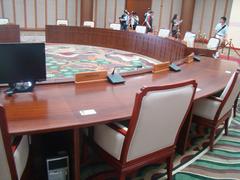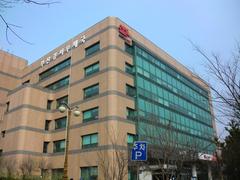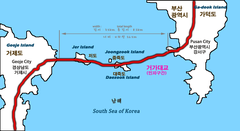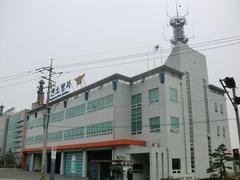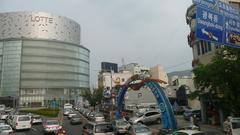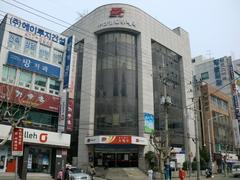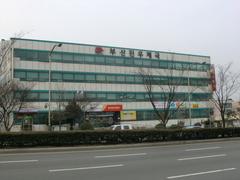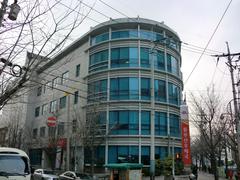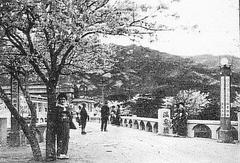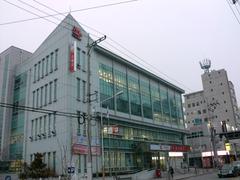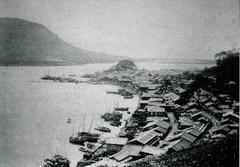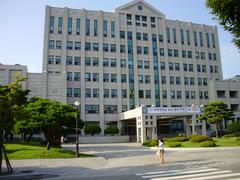Modeok Station Visiting Hours, Tickets, and Busan Historical Sites Guide
Date: 04/07/2025
Introduction: Modeok Station and Its Role in Busan
Busan, South Korea’s dynamic coastal metropolis, is renowned for its blend of ancient heritage and modern vibrancy. At the crossroads of tradition and urban innovation lies Modeok Station, a key access point in the Sasang District. As a pivotal stop on Busan Metro Line 2, Modeok Station serves both daily commuters and visitors seeking authentic local experiences and access to significant historical and cultural sites.
This guide provides a comprehensive overview of Busan’s historical evolution, the importance of Sasang District, and everything you need to know about visiting Modeok Station. It covers practical details such as operating hours, ticketing options, accessibility, and highlights nearby attractions—including the Modeok Monument, local markets, and renowned cultural sites like Gamcheon Culture Village and Beomeosa Temple.
To ensure a rewarding and efficient visit, this article integrates historical context, transit guidance, and cultural highlights. For real-time updates and further details, consult resources like the Busan Metro official website, Busan Navi, Road Affair, and Travel80.
Contents Overview
- Busan’s Historical Evolution
- Sasang District: Transportation & Commerce
- Modeok Station: Access, Facilities & Ticketing
- Nearby Historical & Cultural Attractions
- Practical Visitor Tips
- Modeok Monument: Visiting Guide
- Local Experiences Around Modeok Station
- Frequently Asked Questions (FAQ)
- Key Information Summary
- Sources and Further Reading
Busan’s Historical Evolution: From Ancient Port to Modern City
Busan’s roots stretch back to Neolithic settlements, gaining prominence during the Gaya confederacy as a major maritime hub. Its strategic coastal position fostered centuries of trade and cultural exchange, particularly under the Silla Kingdom and later the Joseon Dynasty, when Busan served as a gateway for international commerce (Travel80).
During the late 19th and early 20th centuries, Japanese colonial rule brought rapid industrialization and infrastructure development, much of which still shapes Busan’s urban landscape. The Korean War marked another pivotal era, with Busan serving as a temporary capital and refuge, instilling a spirit of resilience that continues to define the city today.
Sasang District: Transportation & Commercial Hub
Sasang District (Sasang-gu) is a vital transportation and commercial center in western Busan, linking the city to regional and national destinations (Busan Navi).
Transportation Access
- Sasang Station: Connects Metro Line 2 with the Busan-Gimhae Light Rail, offering direct routes to Gimhae International Airport and the historic city of Gimhae.
- Busan Western Bus Terminal: Major hub for intercity and express buses, facilitating travel to destinations across southern Korea.
- Gyeongbu Line: Provides KTX high-speed rail access to Seoul and beyond.
Commercial & Cultural Life
Sasang District boasts bustling shopping centers—E-Mart, Homeplus, Renesite—and an energetic food scene with specialties like milmyeon (wheat noodles) and tteokbokki. The area’s history of migration, especially during the Korean War, has fostered a diverse and entrepreneurial community (Busan Navi).
Modeok Station: Access, Facilities & Ticketing
Station Overview
Modeok Station is an underground stop on Metro Line 2, serving Sasang District’s residential, business, and educational areas. It offers an authentic slice of local daily life, away from the city’s main tourist crowds.
Facilities
- Elevators and Escalators: Fully accessible for all travelers
- Restrooms: Clean, located near ticket gates
- Lockers: Short-term storage available
- Automated Ticket Machines: Multilingual support
- Information Displays: Real-time schedules in Korean and English
- Safety: CCTV coverage and emergency call points
Visiting Hours
- First Train: ~5:15 AM
- Last Train: ~12:30 AM
- Frequency: Every 5–8 minutes during peak hours; every 8–12 minutes off-peak (Busan Metro Schedule)
Ticketing Options
- T-Money Card: Rechargeable, accepted on buses, subways, and some taxis (T-Money info)
- Single Journey Tickets: Purchase at vending machines
- Fare: ~1,400 KRW per adult ride with T-Money; cash fares slightly higher (Road Affair)
Nearby Historical & Cultural Attractions
Modeok Monument
Other Sights
- Gamcheon Culture Village: Famous for colorful art installations and scenic alleys (SeoulKoreaAsia)
- Beomeosa Temple: A historic Buddhist site in the city’s northeast
- Nakdong River Parks: Riverside parks perfect for walks and festivals
- Sasang Market: Sample classic Busan street food such as eomuk, tteokbokki, and hotteok (GoblinKorea)
Practical Visitor Tips
- Public Transportation: Use rechargeable IC cards for discounts; combine metro and buses for efficient travel (Prepare Travel Plans: Busan Metro tips)
- Accessibility: All metro stations, including Modeok, are wheelchair-accessible with elevators and tactile paving (Busan Metro Accessibility)
- Safety and Cleanliness: Eating and drinking are discouraged on trains and platforms
- Language: Most signage is bilingual; translation apps may be helpful
- Luggage Storage: Limited at Modeok Station; more options at Busan Station (KoreaToDo)
- Weather: Summers are hot and humid; pack accordingly (Busan Weather in July)
Modeok Monument: Visiting Guide
History & Significance
The Modeok Monument honors Busan’s regional leaders from the Joseon era, symbolizing community and resilience. Its traditional stonework and gardens offer a peaceful setting and educational value.
Visiting Details
- Hours: 9:00 AM – 6:00 PM
- Tickets: 2,000 KRW (adults), 1,000 KRW (children/seniors), free for kids under 7 and Busan residents
- Access: A 10-minute walk from Modeok Station; also reachable by bus or taxi
- Accessibility: Wheelchair-friendly, tactile paving, accessible restrooms
- Guided Tours: Daily at 10:00 AM and 2:00 PM; audio guides in Japanese/Chinese available
- Events: Seasonal performances and reenactments
Photography & Nearby Sights
- Photo Tips: Best lighting in early morning or late afternoon; gardens and panoramic city views
- Combine With: Gamcheon Culture Village, Jagalchi Fish Market, Busan Tower
Local Experiences Around Modeok Station
In Deokpo-dong & Sasang District
Explore vibrant neighborhoods, traditional markets, and cozy cafés. Sasang Market is a must for foodies, while nearby bakeries and tea shops offer a taste of Korean café culture.
Cultural Landmarks Easily Reached
- Gamcheon Culture Village: Free entry; some galleries charge a fee
- Beomeosa Temple: Free entry; small fees for special programs
- Gukje Market & Jagalchi Fish Market: Open 8:00 AM–8:00 PM
- Festivals: Busan International Film Festival (October), Waterbomb Festival in summer (KoreaToDo)
Transportation Tips
- Metro: Modeok (Line 2) connects to Seomyeon, Haeundae, and Gwanganli Beach (Wikipedia)
- Airport: Gimhae International Airport 20 minutes away by metro/light rail
- Navigation: Use Naver Maps or KakaoMap for real-time directions
Accommodation & Shopping
- Guesthouses and business hotels near the station
- Shopping at Busan Station Underground Mall, Gukje Market, and Sasang Market for souvenirs (Away to the City)
Budget-Friendly Tips
- Many attractions are free; use Visit Busan Pass for discounts (Zen Moments in Korea)
- Flexible tour options available with 24-hour cancellation
Frequently Asked Questions (FAQ)
Q: What are the operating hours of Modeok Station?
A: Approximately 5:00 AM to midnight daily.
Q: How do I get to Gimhae’s historical sites from Modeok Station?
A: Take Metro Line 2 to Sasang, transfer to the Busan-Gimhae Light Rail, or use local buses (20–30 minutes).
Q: Can I use one IC card for all transport in Busan?
A: Yes; T-Money, Cashbee, and Hanaro cards work on buses, subways, and some taxis.
Q: Is there luggage storage at Modeok Station?
A: Some lockers for small/medium bags; Busan Station offers larger facilities.
Q: Are guided tours available at Modeok Monument?
A: Yes, twice daily in Korean and English; audio guides in Japanese and Chinese.
Summary of Key Visiting Information and Tips
Modeok Station is more than just a transit hub—it’s a gateway to Busan’s rich history, vibrant culture, and authentic local experiences. With modern facilities, excellent accessibility, and seamless connections to major attractions, the station is ideal for travelers eager to explore Busan’s dynamic neighborhoods, historical sites, and culinary highlights.
Utilize digital tools like Naver Maps, KakaoMap, and the Audiala app for real-time updates and travel planning. For further details, check the Busan Metro and Busan Tourism Guide.
Embark on your Busan adventure through Modeok Station and discover the city’s welcoming spirit, historical depth, and vibrant daily life.
Sources and Further Reading
- travel80.com
- busannavi.net
- Busan Metro official site
- GoblinKorea
- Busan Metro Schedule
- Road Affair
- KoreaToDo
- Busan City Official

